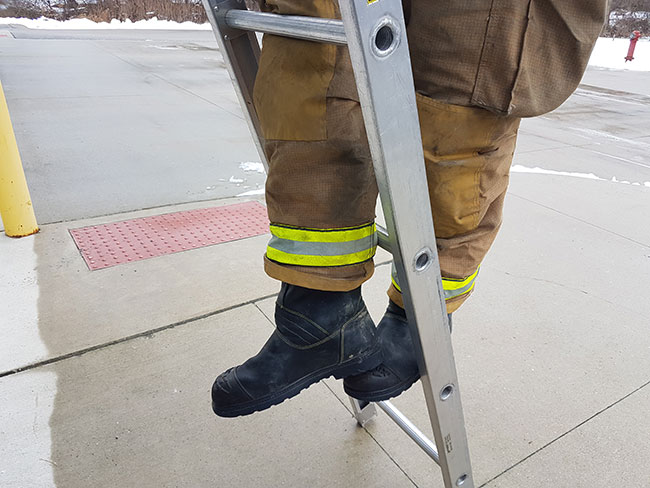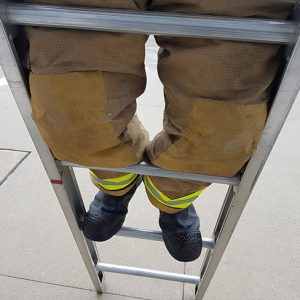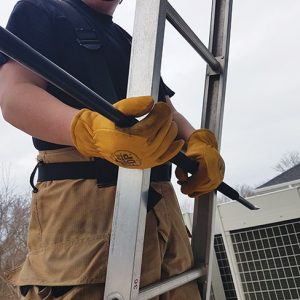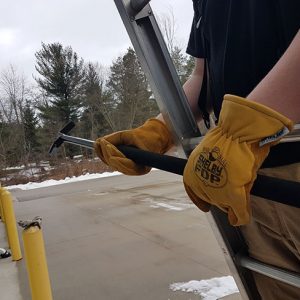
Features
Back to Basics: Ladder dating series — Working on the ladder
February 26, 2021
By
Mark van
 The heel-toe method is a hybrid version of the leg lock where the leg is only going through the rung and resting on the foot. Photos by Mark van der Feyst
The heel-toe method is a hybrid version of the leg lock where the leg is only going through the rung and resting on the foot. Photos by Mark van der Feyst
The ground ladder is looked upon as a device used to gain access to an upper portion of the building or to get down from an upper portion of the building, but there is more to the ground ladder than just access. Sometimes the need to work on or off the ladder must be done to accomplish certain tasks. As we continue our look into ground ladders, we are going to focus on working off or working on the ladder.
When we mention working off or on the ladder, we are including such tasks as breaking windows, venting windows, overhauling around windows, overhauling under the eaves, applying water into the building, bringing up tools, bringing people down the ladder, cutting the wall open for a RIT operation or occupant removal operation, etc. There is no limit to what can be done on a ground ladder for fire ground operations.
The main issue with working off or on a ground ladder is losing one’s balance and falling to the ground. Whenever a fall occurs off a ground ladder, injuries will certainly be sustained. The severity of them will be dictated by the height of the fall and the weight of the firefighter. Some of the reasons why a firefighter may fall from a ground ladder are not preventable, such as an object falling off from the roof like snow (in a good chunk) or a person jumping from above. Other times it is due to overreaching and trying to work too far off the ladder. This can be prevented.
The basic method taught to prevent falling is to use a leg lock on the ladder. This is where the leg of the firefighter is completely wrapped around the beam of the ladder after stepping through one of the rungs. As basic as the leg lock is, it is not practical for the firefighter (and I would go one step further and state that it is not safe for the firefighter either). Once the firefighter is locked into the ladder they are a part of the ladder. Should the ladder fall or move, the firefighter is going with it. They will not have a chance to jump off the ladder or even get out of the leg lock fast enough. For most firefighters, getting out of the leg lock is the hard part under normal circumstances. Try doing it quickly!
What can be done instead? There are three other options that are available to use. These options are not my creation but rather Lt. Michael Ciampo’s from FDNY. He is regarded as the top ladder expert in the country and has been teaching these options for several years.
The first option is called the heel-toe method as seen in Photo 1. This is a hybrid version of the leg lock where the leg is only going through the rung and resting on the foot. The heel of the leg through the rung is resting on the toe cap of the other foot. This adaption comes over from the iron worker side of the trade as this is what they use when working on a ladder. This will allow a firefighter to be on a ladder without being locked into it. Should they have to get off the ladder quickly, they can do so much easier than if they were locked in with the leg lock.
The second option is the knee method as seen in Photo 2. With this option, the firefighter is pushing or pressing their knees against the inside of the beam of the ladder. This stance allows for a more balanced approach to working on the ladder while at the same time, being grounded with the ladder. Both feet are on the rung, giving the firefighter a balanced feeling. In option one, the firefighter may feel unbalanced with only one foot on the rung. By having both knees pressing against the inside of the beams, the firefighter can easily work off the ladder without overreaching and feel secure. Should they need to get off the ladder quickly, they can do so by just climbing down. Or, if they must ascend the ladder quickly, they can.
The third option is the tool method as seen in Photo 3 and Photo 4. With this option, the firefighter is using the hand tool to secure themselves to the ladder. Notice in Photo 4 how the firefighter has their one arm through the rung of the ladder and the other arm is on the outside of the ladder beam. This is the key to this method. The hand tool that is being held by both hands locks the firefighter in to the ladder allowing them to work off it.
In Photo 3, you will see how the tool secures them in. Should the firefighter lose their balance, as they are holding onto the hand tool, the hand tool will come in contact with the ground ladder, preventing the firefighter from falling. In this position, the firefighter can easily break glass for venting or forcible entry purposes. If they are holding onto a handline, the same thing can be done, securing the firefighter to the ladder. As with the other options, should the firefighter need to quickly get off the ladder, they can do so by letting go of the hand tool from the one hand and climbing down.
Mark van der Feyst has been in the fire service since 1999 and is currently a firefighter with the FGFD. He is an international instructor teaching in Canada, the United States, FDIC and India. He is a local level suppression instructor for the Pennsylvania State Fire Academy and the lead author of Fire Engineering’s Residential Fire Rescue book and other DVDs. He can be contacted at Mark@FireStarTraining.com.
Print this page
Advertisement
- Well-Being: Strategies to boost energy during COVID
- Fire Fighting in Canada This Week – February 26, 2021


